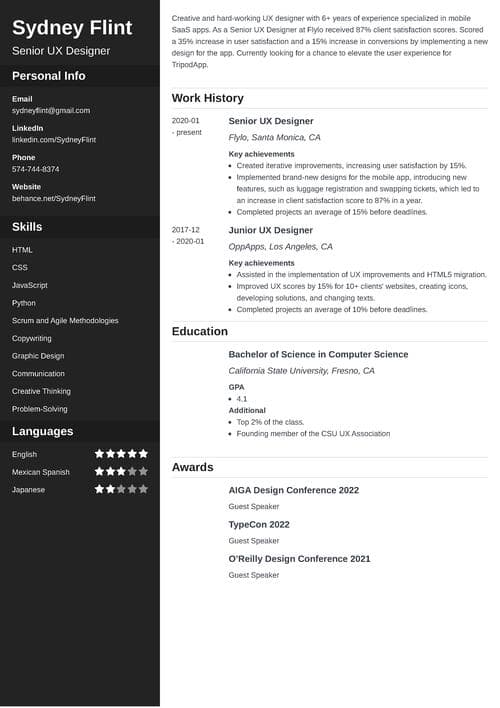How to Make a Perfect Portfolio Resume: 2025 Guide
Create Your Resume NowYou have an extraordinary resume and an outstanding cover letter, but maybe you need one more thing to ace that job application? The question is…
How can you make an impressive portfolio resume?
Don’t worry! We’re here to answer all your questions. After reading our guide, you will know everything there is to find out about creating an amazing resume portfolio.
This guide will show you:
- What is a portfolio resume.
- How to create a resume portfolio.
- Do you even need a portfolio resume.
Want to save time and have your resume ready in 5 minutes? Try our resume builder. It’s fast and easy to use. Plus, you’ll get ready-made content to add with one click. See 20+ resume templates and create your resume here.
Sample resume made with our builder—See more resume examples here.
What Is a Portfolio Resume?
A portfolio resume combines both resume and portfolio into a single document that shows your previous work. It can easily help you highlight your skills, talents, and greatest achievements. It is used to impress the hiring managers with what you have accomplished and are capable of doing.
Of course, not every job opening requires a resume portfolio. However, it is more than welcome in some industries. You should include a resume portfolio if you’re sending the following resumes:
- 3D Artist Resume
- Architecture Resume
- Copywriter Resume
- Cosmetologist Resume
- Fashion Designer
- Fashion Stylist
- Writer Resume
- Photographer Resume
- Model Resume
- Illustrator Resume
- Hair Stylist Resume
- Graphic Designer
- Software Engineer Resume
- Front End Developer Resume
- User Experience (UX) Designer
- Web Designer Resume Example
As you can see, most of these jobs are strictly related to some sort of art or design. However, if you work in a different industry, you can also benefit from showing your skills and qualifications rather than simply describing them in a resume or as a part of your job-winning cover letter.
According to the Gartner report, recruitment is a top priority for almost half of HR leaders. Furthermore, 36% claim that their previous strategies are insufficient for finding new employees. So maybe creating a portfolio resume will make them feel like this time the decision (backed with excellent examples of your work) is right?
However, creating a one-page document comprising your resume and portfolio can be very tricky. It is almost impossible to deliver all the necessary information regarding your experience, education, skills, and examples of your accomplishments. That’s why having them separated yet in the same format and template can be both easier and way more effective. It boosts readability while impressing the viewer. And that’s what you’re aiming for!
But hold on! We might want to answer one question before we move on with creating a resume portfolio!
What Is the Difference Between a Portfolio and a Resume?
A resume is a formal document that shows a candidate’s career background, education, and skills. In most cases, it’s created in order to help a candidate get hired. It’s a document that helps you present your qualifications and secure an interview.
A traditional resume consists of the following parts:
- Professional Resume Summary or Resume Objective,
- Experience Section
- Education Section
- Skills Section
- Additional Sections (i.e., languages, interests, certificates, publications, awards, etc.)
Having your resume done perfectly will help you impress the recruiter and boost your chances of getting hired. On the other hand…
A portfolio is a collection of your certificates, letters of recommendation, and, most commonly, samples of your work. It is created as an addition to a resume, and its main goal is to make a great impression on the recruiter. However, there are more things you can accomplish by creating a resume.
A properly constructed portfolio will help you tailor your resume to a specific job opening. With a good portfolio, you can also boost your confidence in your work and abilities, which leads to finding a better job and boosting your chances of getting a raise or a promotion.
In other words: a resume is how you summarize information about your career. A portfolio is how you prove what you wrote in your resume is true. So let’s say you’re a graphic designer. You write about an image you created for a viral social media ad on your resume. It reached 100k followers, received 50k reactions and 25k comments, and had a 5% CTR to the landing page with a product your company was selling… In this case, including that image in your application documents is a good idea. And a portfolio is a perfect place to do it!
Now that you know the difference, let’s learn more about creating a job-winning resume: How to Build a Resume
What to Include in Your Resume Portfolio?
Did you know that 91% of freelancers find their job via referrals and word of mouth? Having a neatly done portfolio will only help your previous clients share your work with your potential clients.
That’s why figuring out what to add to your resume portfolio is crucial. And there are several things you might want to choose from:
Your work
Samples of your work, whether it’s pictures of your modeling, photos of makeup you’ve done for a wedding, or a video of you acting on Broadway, are the most common things to include in a portfolio resume. Following the reverse chronology format can be a good idea, but don’t forget to include what’s the most relevant and the most impressive.
Articles in which you're mentioned
Being mentioned in a professional article means you got recognized. Even if you’re not on, let’s say, a cover of National Geographic with your photographs, being included in a local newspaper with a photo of a bold eagle you took, is still something to be proud of. Don’t forget to include it in a portfolio resume for a photographer. The same applies to any other jobs. Having your name printed in press (or online!) counts.
Certifications & Licenses
Have you got any certifications or licenses that prove you’re the right fit for the job? A portfolio resume is a place to include their scans. They can work magic on your resume, as they put you one step ahead of your competitors. They can also work magic on your portfolio resume. Let’s face it: seeing an official license or a nice certificate is always impressive, right? And impressive is what you want your resume portfolio to be!
Kudos
Whether it’s a client review or an endorsement from someone you worked with, kudos matter. They do not show you’re an excellent person to cooperate with but also that the results of your work were great. And you show you have created a network with other professionals willing to say a good word about you.
Pro tip: Always ask for permission before including any kudos, recommendations, or information about your colleagues or clients. Asking for references is a proper way of doing it.
How to Create a Portfolio Resume?
You know what to choose from when creating your resume portfolio. Now let’s find out how exactly you can ace it.
There are some rules you should follow when creating a job-winning portfolio resume:
- Tailor it to the job you’re after by revisiting the job ad. That way, you will know exactly what your portfolio should include, and your recruiters will know that you’ve made this effort, especially for them. That’s making it personal from the very first step! And that alone is quite impressive.
- Gather your work. This part can be tricky if you haven’t been doing that throughout your career. Reaching out to your past employers for work samples is a good idea, but keeping them in a cloud is far better.
- Use only the best quality, the most relevant, and the most impressive samples of your work. No pixelated pictures, no badly cropped images, and no videos of low quality. Only top of the tops!
- Choose different works. Show you’re talented, flexible, and able to deliver different types of work and create in different styles. That’s the best way of showing your versatility.
- Design your portfolio resume. It needs to be neat, organized, and readable, so if you don’t have the skills necessary to tick those three boxes, try to ask for a befriended graphic designer for help or look for a template you can use. When adding photos, don’t make them hang without context. Explain what the viewers are seeing, so they can better understand your work.
- Put your portfolio resume online. Using an online platform for your portfolio, such as WordPress, Behance, Adobe, Weebly, DeviantArt, or Squarespace will allow you to add more samples of your work. It’ll also make it easier for you to promote your work on different social media channels, attract more customers and get more kudos.
- Keep it short. It’s just like having an ideal length of a resume. You don’t want your recruiter to think you have shown them all of your work and achievements. Instead, you want them to believe you’ve only chosen what’s best and most relevant to the opening. And that brings us back to having it tailored especially to a specific job ad. And that’s a win: win!
Making a resume with our builder is incredibly simple. Follow our step-by-step guide, use ready-made content tailored to your job and have a resume ready in minutes.
When you’re done, Zety’s resume builder will score your resume and our ATS resume checker will tell you exactly how to make it better.
Key Takeaways
A portfolio resume can work magic for your job application. Whether you’re a web designer, a model, an actress, or a writer, including your work, kudos, licenses, and publications about you in a message to your recruiter is an impressive move. There are just some things you need to remember when creating a resume portfolio:
- Always tailor it to a specific job opening. That’s how you make it personal.
- Choose only the best content. That’s how you make it the most impressive.
- Put it online. That’s how you get more clients and more reviews.
- Keep it brief. That’s how you show it’s the choice of your work, not the entire work history.
Thanks for reading our article! If you’ve got any questions regarding a portfolio resume, reach out in the comment section below!
About Zety’s Editorial Process
This article has been reviewed by our editorial team to make sure it follows Zety's editorial guidelines. We’re committed to sharing our expertise and giving you trustworthy career advice tailored to your needs. High-quality content is what brings over 40 million readers to our site every year. But we don't stop there. Our team conducts original research to understand the job market better, and we pride ourselves on being quoted by top universities and prime media outlets from around the world.



